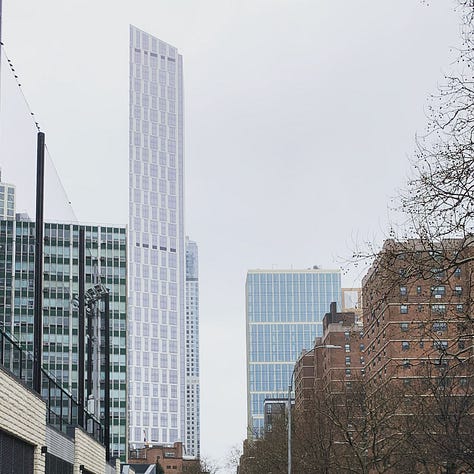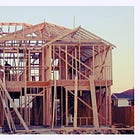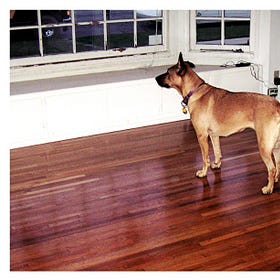Why do most people choose oak for flooring or maple for cabinets? Is it because oak is a hardwood or because it looks attractive? Other people opt for pine cabinets and floors. The choice of whether to use a hardwood like oak or a softwood like pine isn't always clear cut. So, which wood should you use for your next project?

I'm very grateful for the positive feedback via email. I'd appreciate it if you could help by sharing, liking, or leaving a comment directly on these posts. Thank you for your continued support.
The topic of hardwood vs. softwood is a boring one that I wasn't keen on writing about, but it's important because of its ramifications. Like most people, I was familiar with the terms hardwood and softwood. I knew hardwoods were typically denser and and harder than softwoods but I didn’t realize this isn’t always true.
Trees are traditionally classified into two categories: hardwoods and softwoods, designations that have endured for centuries. Hardwoods, typically deciduous trees with broad leaves, tend to shed their leaves in the fall or winter. In contrast, softwoods, often referred to as evergreens, are characterized by their needle-like or scale-like leaves.
Demystifying the terminology
The terms hardwood and softwood were originally applied based on the perceived hardness or softness of the wood, with hardwoods being thought of as harder and denser than softwoods. This makes sense as hardwoods were more commonly used for things like furniture and construction, which required durable and sturdy materials. Softwoods were more commonly used for things like paper and construction framing, which didn't necessitate the same level of hardness.
However, it's important to note that the terms do not necessarily indicate the hardness or softness of the wood. In fact, some hardwoods can be softer than some softwoods. Consequently, these labels can be misleading. So, what is the basis for these terms?
Hardwoods and tomatoes share an unexpected trait
Hardwoods and softwoods are primarily classified based on the botanical origin and characteristics of trees, which stem from their reproductive structures. Hardwood trees are typically angiosperms, which produce seeds enclosed in some type of fruit or nut. In contrast, softwood trees are usually gymnosperms, which produce seeds that are not enclosed and are often found on the surface of cones or similar structures.
In the case of hardwood trees, the seeds are encased in a structure like a nut or a fruit. This protective covering helps safeguard the seeds as they develop and eventually fall to the ground, where they can germinate and grow into new trees. Tomatoes, although not trees but herbaceous plants, have a fleshy interior that encases their seeds. So, while a hardwood tree and a tomato may appear quite distinct at first glance, they share this fascinating similarity.
There is a significant difference in the number of species between these two groups. There are approximately 300,000-500,000 species of angiosperms and only about a 1,000 species of gymnosperms. Angiosperms encompass a wider range of plants, including all the fruits and vegetables we consume, deciduous trees and shrubs, and various other flora.
More boring botany
Botany was one of my favorite subjects in school, but I soon realized it had more to do with the fact that we could draw pictures in that class. Here, I've attempted to clean up a horrendously bad scientific drawing to provide clarity on how hardwoods and softwoods differ in their cell structure. Both have cells for water and nutrient transport but the cell types and distribution mechanisms differ.

In any tree trunk, whether hardwood or softwood, the sapwood is the living, outer part, while heartwood is the non-living portion that provides structural support. Xylem tissue is responsible for transporting water and minerals up the tree while phloem is responsible for moving food and nutrients around the tree. Hardwood trees have cells called vessel elements in their xylem which are arranged in a radial pattern. The cells run alongside the tree’s growth rings and contribute to the overall wood grain. Some common American hardwood species include oak, maple, cherry, and walnut, while most imported tropical woods are hardwoods.
Softwoods don't have vessels and they have tracheids, which are elongated tapering cells. The tracheids are distributed more evenly throughout the wood, which makes the wood appear more uniform. Common softwoods include pine, spruce, cedar, and fir.

Hardwoods vs. softwoods
Tropical regions are rich in hardwoods, which are ideal for withstanding humidity and pests. These regions also have a long history of using hardwood for local constructions and crafts. I had grown up with hardwood cabinets, furniture and veneers. I was always surprised by the North American predilection to pine over hardwood, as the latter always felt more substantial. However, it makes sense, as North America is home to several species of softwood trees that are abundant in many regions.

Despite the fact that early log cabins were made of hardwoods, the later use of pine has become a symbol of early American architecture. European settlers in North America during the colonial era discovered vast pine and other softwood forests. The ready availability of softwoods in some regions made it a convenient and cost-effective choice for various applications. Settlers quickly recognized the utility of softwoods for building, and it became a construction material for homes, furniture, and ships. Just as hardwoods have a reputation for superior strength and durability, softwoods are often favored for their workability. These characteristics make them excellent choices for a wide range of applications. Pine and other softwoods like fir, cedar, and spruce remain a culturally significant choices for Americans.

Pros and cons
Approximately 80% of timber consists of softwood. Softwoods are preferred for their availability and cost-effectiveness. They hold an advantage in terms of accessibility and ease of manipulation due to their lighter weight and lower density compared to most hardwoods. Their versatility extends to a diverse array of both indoor and outdoor projects, including furniture, flooring, decking, landscaping, external joinery, and structural applications. In addition, softwoods are commonly used in the creation of interior moldings, window manufacturing, construction framing, and the production of sheet goods like plywood and fiberboard.
The choice between hardwoods and softwoods depends on the specific needs of the project. Here are some general benefits. In the follow-up post, there are more specific advantages and disadvantages related to usage.
Hardwoods
Durability: Hardwoods are known for their durability and resistance to wear and tear. They are less prone to denting and damage compared to softwoods, making them suitable for high-traffic areas and applications that require longevity.
Strength: Hardwoods are typically stronger than softwoods, which makes them suitable for structural applications, furniture, and flooring that need to bear heavy loads.
Inherent aesthetics: They are often chosen for their aesthetic appeal due to their beautiful grain patterns and rich natural colors often to create a luxurious look.
Staining and finishing: Hardwoods readily accept stains, finishes, and varnishes, allowing for a wide range of customizations.
Longevity: Hardwoods can last for decades and even centuries, making them a sound investment.
Resistance: Many hardwoods are naturally resistant due to their density and chemical composition. This makes them ideal for outdoor applications and areas prone to moisture or pests.
Sustainability: Some hardwoods are sourced from sustainably managed forests or plantations. Look for certifications like FSC® (Forest Stewardship Council®) or PEFC™ (Programme for the Endorsement of Forest Certification) to ensure that the wood has been responsibly harvested.
Versatility: Hardwoods can be used for a wide range of applications, from furniture and cabinetry to flooring, millwork, and structural components. Their versatility makes them a popular choice for various projects.
Resale value: Homes that use hardwoods often have a higher resale value due to the perception of quality and durability.
Disadvantages
Cost: Hardwood trees grow at a significantly slower rate, necessitating longer drying times, which, in turn, increases their cost.
Workability: Hardwoods can be more challenging to work with, may require more effort and specialized tools.
Weight: They are less suitable for applications where weight is a concern, such as in construction or furniture.
Warping and splitting: Hardwoods can be more prone to warping and splitting if not properly seasoned and dried before use.
Environmental concerns: Harvesting hardwoods can lead to habitat loss and affect local ecosystems.
Softwoods
Cost-Effective: Softwoods are generally more affordable than hardwoods, making them a cost-effective choice.
Availability: Softwood trees grow relatively quickly, which means a readily available supply.
Workability: Softwoods are easier to cut, shape, and join due to their softer and less dense nature.
Versatility: Softwoods can be used for various construction purposes, including framing, sheathing, and interior finishes.
Lightweight: Softwoods are lighter which can be advantageous in applications where weight is a consideration.
Sustainability: Many softwood species are sustainably harvested, making them an environmentally friendly choice when sourced responsibly.
Disadvantages
Warping and shrinking: Softwoods are more prone to warping, twisting, and shrinking as they dry, which can affect the integrity of construction projects.
Difficulty in staining: Softwood can be more challenging to stain evenly, as it may absorb stain unevenly due to variations in its grain and density.
Limited outdoor applications: Softwoods are typically more prone to decay, rot, and insect infestations, making them less suitable for outdoor applications without proper treatment. Some species can be treated to increase their resistance to rot, insects, and decay. Pressure-treated softwood is commonly used for exterior applications where it's exposed to moisture.
Fire-resistance: Softwoods are generally less fire-resistant than hardwood due to its lower density and higher resin content.
How to choose
Application: Hardwood for durability, strength, and aesthetic appeal in furniture or flooring. Softwood for cost-effective and versatile uses in construction and indoor projects.
Availability: Choose the wood type commonly found in your region for cost-effectiveness and sustainability.
Sustainability: Opt for responsibly sourced wood to support eco-friendly practices.
Characteristics: Assess hardness, grain pattern, and workability based on your project's requirements.
Preference: Select the wood type that aligns with your design and aesthetic preferences.
The original post has now been split into two for better readability. So if you came here via email, continue on >
Thank you for reading. Please share, like or leave a comment on these posts, which will help me reach a wider audience. Thank you for your continued support!
Related content:
The Finish I Dreaded
There is a lack of clear and complete information about floor finishing products. Most articles don’t differentiate sealers from finishes or provide a clear overview of available options. If you don’t understand the options and differences you may make a choice that you later regret.
Tread Wisely
(Paid post) When I see posts like ‘The top natural oils for floors’, I am skeptical that most people would know why they should use oil vs. another finishing product. Here’s a clear overview of most of the sealers and finishes available today.
If you like this post, please share or heart. If you like Architecture, please follow my Instagram.



Queen’s Repository
Cell types in hardwoods and softwoods
Hardwoods and softwoods have distinct types of cells within their xylem, the plant tissue responsible for transporting water and minerals from the roots throughout the plant. Hardwoods exhibit a greater variety of cell types compared to softwoods. Notably, hardwoods are the only type to possess vessels, also known as pores, which are wide, short, and cylindrical cells that stack together to create efficient pathways for water transport. These vessels play a significant role in determining the wood's grain pattern.
On the other hand, conifer trees, which are a type of softwood, feature tracheids. Tracheids are long, narrow, and tapering cells that are interconnected to transport water and minerals. Consequently, conifer woods typically have a more open and permeable structure when compared to hardwoods. This characteristic arises from the prevalence of tracheids, even though these tracheids are smaller than vessels in hardwoods.









About six decades back I read an ancient book about the German Black Forest ; thus began an amateur love for forest trees and later wood. Among the hard woods I was fascinated with the one hundred or two hundred years old towering teak and rosewood trees which were common in the area where I worked then. Owing to unending demand teak has become scarce and rosewood unattainable. We need to plant and protect such species. This sound article took me back to old times. I hope this article will create awareness of the environment which we need to sustain for it is the environment which will sustain us.